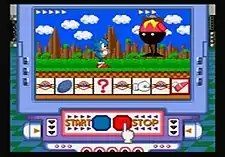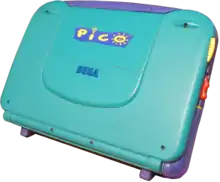Sega Pico
The Sega Pico, also known as Kids Computer Pico,[lower-alpha 1] is an educational video game console by Sega Toys. Marketed as "edutainment", the main focus of the Pico was educational video games for children between 3 and 7 years old. The Pico was released in June 1993 in Japan and November 1994 in North America and Europe, later reaching China. It was succeeded by the Advanced Pico Beena, which was released in Japan in 2005. Though the Pico was sold continuously in Japan through the release of the Beena, in North America and Europe the Pico was less successful and was discontinued in early 1998, later being re-released by Majesco Entertainment. Releases for the Pico were focused on education for children and included titles supported by licensed franchised animated characters, including Sega's own Sonic the Hedgehog series. Overall, Sega claims sales of 3.4 million Pico consoles and 11.2 million game cartridges, and over 350,000 Beena consoles and 800,000 cartridges.
 | |
 | |
| Also known as | Kids Computer Pico |
|---|---|
| Manufacturer | Sega Toys |
| Type | Video game console |
| Generation | Fourth generation era |
| Release date | |
| Introductory price | JP¥13,440 US$139 CN¥690 US$49.95 (Majesco) |
| Discontinued | |
| Units sold | |
| Media | "Storyware" (Cartridge) |
| CPU |
|
| Memory | 64 KB RAM, 64 KB VRAM, 8 KB audio RAM |
| Display | |
| Sound |
|
| Successor | Advanced Pico Beena |
Design and software


Powered by the same hardware used in the Sega Genesis,[1] the physical shape of the Pico was designed to appear similar to a laptop. Included in the Pico is a stylus called the "Magic Pen", and a pad to draw on. Controlling the games for the system is accomplished either by using the Magic Pen like a mouse, or by pressing the directional buttons on the console. The Pico does not include a screen, and instead must be connected to a monitor through the Composite video output.[2] Touching the pen to the pad allows drawing, or moving/animating a character on the screen.[3]
Cartridges for the system were referred to as "Storyware", and took the form of picture books with a cartridge slot on the bottom. The Pico changes the television display and the set of tasks for the player to accomplish each time a page is turned.[2] Sound, including voices and music, also accompanied every page. Games for the Pico focused on education, including subjects such as music, counting, spelling, reading, matching, and coloring. Titles included licensed animated characters from various franchises, such as Disney's The Lion King: Adventures at Pride Rock and A Year at Pooh Corner. Sega also released titles including their mascot, Sonic the Hedgehog, including Sonic Gameworld[3] and Tails and the Music Maker.[4]
According to former Sega console hardware research and development head Hideki Sato, the development of the Sega Pico was possible due to the company's past work on the MyCard cartridges developed for the SG-1000, as well as on drawing tablets. The sensor technology used in the pad came from that developed for the 1987 arcade game World Derby, while its CPU and graphics chip came from the Genesis.[5]
History
At a price of ¥13,440,[6] the Pico was released in Japan in June 1993.[7] In North America, Sega unveiled the Pico at the 1994 American International Toy Fair, showcasing its drawing and display abilities[8] ahead of its release in November.[9] The console was advertised at a price of approximately US$160,[10] but was eventually released at a price of US$139. "Storyware" cartridges sold for US$39.99 to 49.99. The Pico's slogan was "The computer that thinks it's a toy."[3] The Sega Pico won a few awards, including the "National Parenting Seal of Approval", a "Platinum Seal Award", and a gold medal from the "National Association of Parenting Publications Awards".[11]
After a lack of success, Sega discontinued the Pico in North America in early 1998. Later, in August 1999, a remake of the Pico made by Majesco Entertainment was released in North America at a price of US$49.99, with Storyware titles selling at US$19.99.[12][13] The Pico would later be released in China in 2002, priced at ¥690 RMB.[14]
In early 1995, Sega of America reported that it had sold 400,000 units in North America.[15] In 2000, Sega claimed that the Pico had sold 2.5 million units.[6] As of April 2005, Sega claims that 3.4 million Pico consoles and 11.2 million software cartridges had been sold worldwide.[16] The Pico was recognized in 1995 by being listed on Dr. Toy's 100 Best Products, as well as being listed in Child as one of the best computer games available. According to Joseph Szadkowski of The Washington Times, "Pico has enough power to be a serious learning aid that teaches counting, spelling, matching, problem-solving, memory, logic, hand/eye coordination and important, basic computer skills."[17] Former Sega of America vice president of product development Joe Miller claims that he named his dog after the system because of his passion for the console.[1] By contrast, Steven L. Kent claims that Sega of Japan CEO Hayao Nakayama watched the Pico "utterly fail" in North America.[18]
Advanced Pico Beena
 | |
| Manufacturer | Sega Toys |
|---|---|
| Type | Video game console |
| Generation | Sixth generation era |
| Lifespan |
|
| Media | Storyware |
| CPU | ARM7TDMI clocked at 81MHz |
| Predecessor | Sega Pico |
The Advanced Pico Beena, also known simply as Beena or BeenaLite, is an educational console system targeted at young children sold by Sega Toys, released in 2005 in Japan. It is the successor to the Pico, and marketed around the "learn while playing" concept. According to Sega Toys, the focus of the Advanced Pico Beena is on learning in a new social environment, and is listed as their upper-end product. Topics listed as being educational focuses for the Beena include intellectual, moral, physical, dietary, and safety education.[16] The name of the console was chosen to sound like the first syllables of "Be Natural".[19]
Compared to the Pico, Beena adds several functions. Beena can be played without a television, and supports multiplayer via a separately sold additional Magic Pen. The console also supports data saving. Playtime can be limited by settings in the system. Some games for the Beena offer adaptive difficulty, becoming more difficult to play based on the skill level of the player.[20] The Beena Lite, a more affordable version of the console, was released on July 17, 2008. As of 2010, Sega estimated that 4.1 million Beena consoles had been sold, along with 20 million game cartridges.[21]
See also
- List of Sega Pico games
References
- Horowitz, Ken (February 7, 2013). "Interview: Joe Miller". Sega-16. Archived from the original on June 20, 2018. Retrieved January 10, 2014.
- "Sega's Younger Side: Pico and Sega Club Software". GamePro. No. 65. IDG. December 1994. p. 80.
- Beuscher, David. "Sega Pico - Overview". AllGame. Archived from the original on April 24, 2011. Retrieved September 1, 2014.
- "Tails and the Music Maker". AllGame. Archived from the original on November 16, 2014. Retrieved November 12, 2012.
- Sato, Hideki (November 1998). "The History of Sega Console Hardware". Famitsu (in Japanese). ASCII Corporation. Retrieved March 5, 2019 – via Shmuplations.
- "Sega Pico information" (in Japanese). Sega Toys. Archived from the original on April 8, 2009. Retrieved March 3, 2018.
- "Sega Pico Q&A" (in Japanese). Sega Toys. Archived from the original on August 27, 2008. Retrieved March 3, 2018.
- Fainaru, Steve (February 18, 1994). "It may be a Toy Fair, but it ain't kid stuff: High-tech goods shine at industry show". The Boston Globe. Archived from the original on September 24, 2014. Retrieved September 1, 2014 – via HighBeam Research.
- "Sega captures dollar share of videogame market -- again; diverse product strategy yields market growth; Sega charts path for 1996". Business Wire. January 10, 1996. Archived from the original on May 2, 2014. Retrieved September 29, 2011 – via The Free Library.
- Gillen, Marilyn A. (July 9, 1994). "Sega, Nintendo Bring Big Plans To CES". Billboard. Nielsen Business Media, Inc. 106 (28): 73. Retrieved September 29, 2011.
- "Pico Awards". Sega. Archived from the original on March 27, 1997. Retrieved March 3, 2018.
- "Edison, N.J.-Based Firm Signs Video Game Distribution Deal with Sega". Home News Tribune. August 6, 1999. Archived from the original on June 29, 2014. Retrieved September 29, 2011 – via HighBeam Research.
- "Majesco Signs Licensing Deal to Distribute Sega Pico Educational Systems: Systems Will Be Available In All Major Toy Retailers By Holiday Season". Business Wire. August 5, 1999.
- "Sega Toys markets Pico computer toy in China". Japan Toy and Game Software Journal. March 25, 2002. Archived from the original on September 21, 2014. Retrieved September 1, 2014 – via HighBeam Research(subscription required).
- "Sega Boasts Pico Success". Next Generation. February 14, 1996. Archived from the original on April 11, 1997. Retrieved October 17, 2021.
- "Sega Toys Business Strategy". Sega Toys. Archived from the original on December 16, 2005.
- Szadkowski, Joseph (February 26, 1996). "ROMper Room: The Best in Play". The Washington Times.
- Horowitz, Ken (May 9, 2006). "Interview: Steven Kent". Sega-16. Archived from the original on February 23, 2018. Retrieved September 1, 2014.
- "Beena(ビーナ) シリーズ" (in Japanese). Sega Toys. Archived from the original on July 6, 2014. Retrieved October 23, 2014.
- "Beena Q&A" (in Japanese). Sega Toys. Archived from the original on December 12, 2005. Retrieved September 1, 2014.
- "トイ・ストーリー3 がビーナに登場!『Beena専用ソフト シューティングビーナ トイ・ストーリー3 ウッディとバズの大冒険!』とばして!うって!つかまえて!たのしいゲームがい~っぱい!" (PDF). Sega Toys (in Japanese). Sega Toys. July 14, 2010. Archived (PDF) from the original on October 21, 2017. Retrieved February 19, 2022.
External links
- "Sega Pico". Archived from the original on December 19, 1996. - Sega of America
- Pasopico Land - Sega of Japan (in Japanese)